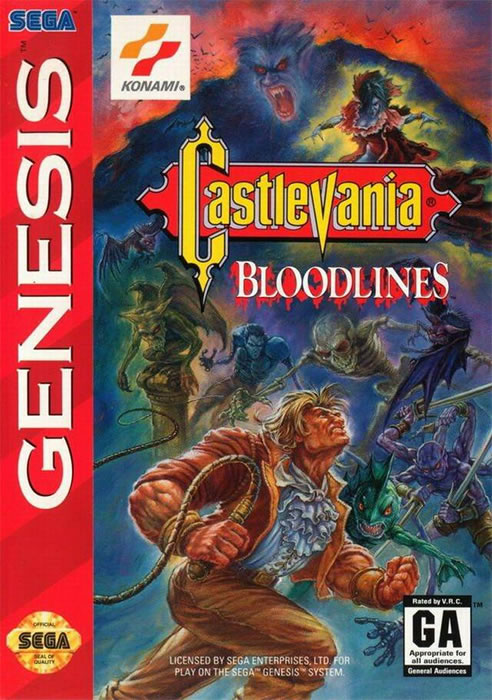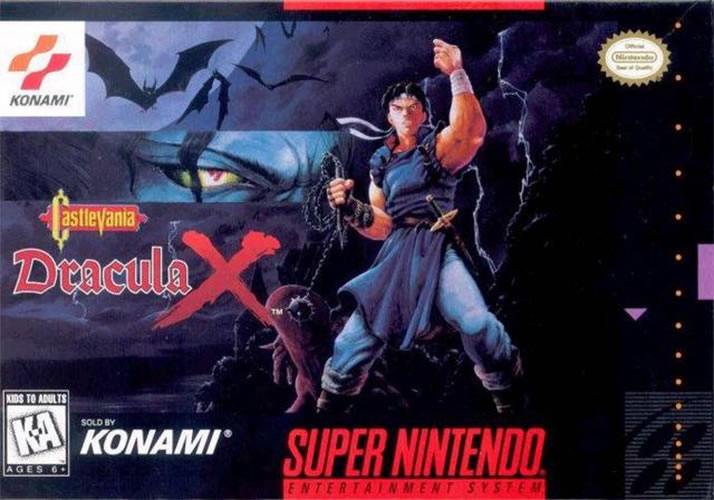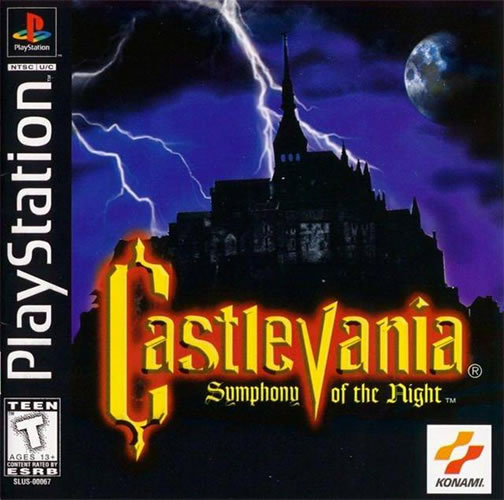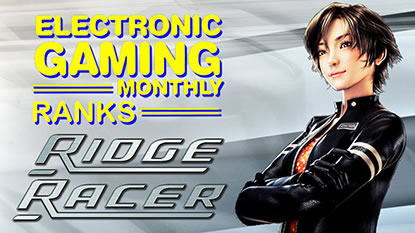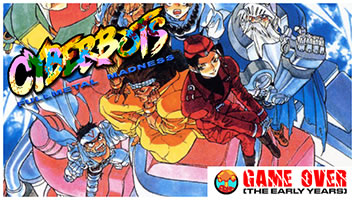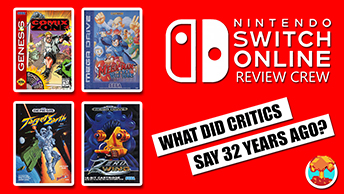- CLASSIC MAGAZINES
- REVIEW CREW
A show recapping what critics thought back
when classic games first came out! - NEXT GENERATION'S BEST & WORST
From the worst 1-star reviews to the best
5-stars can offer, this is Next Generation! - NINTENDO POWER (ARCHIVE)
Experience a variety of shows looking at the
often baffling history of Nintendo Power! - MAGAZINE RETROSPECTIVE
We're looking at the absolutely true history of
some of the most iconic game magazines ever! - SUPER PLAY'S TOP 600
The longest and most ambitious Super NES
countdown on the internet! - THEY SAID WHAT?
Debunking predictions and gossip found
in classic video game magazines! - NEXT GENERATION UNCOVERED
Cyril is back in this spin-off series, featuring the
cover critic review the art of Next Generation! - HARDCORE GAMER MAGAZING (PDF ISSUES)
Download all 36 issues of Hardcore Gamer
Magazine and relive the fun in PDF form!
- REVIEW CREW
- ELECTRONIC GAMING MONTHLY
- ELECTRONIC GAMING MONTHLY RANKS
From Mario to Sonic to Street Fighter, EGM
ranks classic game franchises and consoles! - ELECTRONIC GAMING MONTHLY BEST & WORST
Counting down EGM’s best and worst reviews
going year by year, from 1989 – 2009! - ELECTRONIC GAMING BEST & WORST AWARDS
11-part video series chronicling the ups and
downs of EGM’s Best & Worst Awards!
- ELECTRONIC GAMING MONTHLY RANKS
- GAME HISTORY
- GAME OVER: STORY BREAKDOWNS
Long-running series breaking down game
stories and analyzing their endings! - A BRIEF HISTORY OF GAMING w/ [NAME HERE]
Real history presented in a fun and pithy
format from a variety of game historians! - THE BLACK SHEEP
A series looking back at the black sheep
entries in popular game franchises! - INSTANT EXPERT
Everything you could possibly want to know
about a wide variety of gaming topics! - FREEZE FRAME
When something familiar happens in the games
industry, we're there to take a picture! - I'VE GOT YOUR NUMBER
Learn real video game history through a series
of number-themed episodes, starting at zero! - GREAT MOMENTS IN BAD ACTING
A joyous celebration of some of gaming's
absolute worst voice acting!
- GAME OVER: STORY BREAKDOWNS
- POPULAR SHOWS
- DG NEWS w/ LORNE RISELEY
Newsman Lorne Riseley hosts a regular
series looking at the hottest gaming news! - REVIEW REWIND
Cyril replays a game he reviewed 10+ years
ago to see if he got it right or wrong! - ON-RUNNING FEUDS
Defunct Games' longest-running show, with
editorials, observations and other fun oddities! - DEFUNCT GAMES QUIZ (ARCHIVE)
From online quizzes to game shows, we're
putting your video game knowledge to the test!- QUIZ: ONLINE PASS
Take a weekly quiz to see how well you know
the news and current gaming events! - QUIZ: KNOW THE GAME
One-on-one quiz show where contestants
find out if they actually know classic games! - QUIZ: THE LEADERBOARD
Can you guess the game based on the classic
review? Find out with The Leaderboard!
- QUIZ: ONLINE PASS
- DEFUNCT GAMES VS.
Cyril and the Defunct Games staff isn't afraid
to choose their favorite games and more! - CYRIL READS WORLDS OF POWER
Defunct Games recreates classic game
novelizations through the audio book format!
- DG NEWS w/ LORNE RISELEY
- COMEDY
- GAME EXPECTANCY
How long will your favorite hero live? We crunch
the numbers in this series about dying! - VIDEO GAME ADVICE
Famous game characters answer real personal
advice questions with a humorous slant! - FAKE GAMES: GUERILLA SCRAPBOOK
A long-running series about fake games and
the people who love them (covers included)! - WORST GAME EVER
A contest that attempts to create the worst
video game ever made, complete with covers! - LEVEL 1 STORIES
Literature based on the first stages of some
of your favorite classic video games! - THE COVER CRITIC
One of Defunct Games' earliest shows, Cover
Critic digs up some of the worst box art ever! - COMMERCIAL BREAK
Take a trip through some of the best and
worst video game advertisements of all time! - COMIC BOOK MODS
You've never seen comics like this before.
A curious mix of rewritten video game comics!
- GAME EXPECTANCY
- SERIES ARCHIVE
- NINTENDO SWITCH ONLINE ARCHIVE
A regularly-updated list of every Nintendo
Switch Online release, plus links to review! - PLAYSTATION PLUS CLASSIC ARCHIVE
A comprehensive list of every PlayStation
Plus classic release, including links! - RETRO-BIT PUBLISHING ARCHIVE
A regularly-updated list of every Retro-Bit
game released! - REVIEW MARATHONS w/ ADAM WALLACE
Join critic Adam Wallace as he takes us on a
classic review marathon with different themes!- DEFUNCT GAMES GOLF CLUB
Adam Wallace takes to the links to slice his way
through 72 classic golf game reviews! - 007 IN PIXELS
Adam Wallace takes on the world's greatest spy
as he reviews 15 weeks of James Bond games! - A SALUTE TO VAMPIRES
Adam Wallace is sinking his teeth into a series
covering Castlevania, BloodRayne and more! - CAPCOM'S CURSE
Adam Wallace is celebrating 13 days of Halloween
with a line-up of Capcom's scariest games! - THE FALL OF SUPERMAN
Adam Wallace is a man of steel for playing
some of the absolute worst Superman games! - THE 31 GAMES OF HALLOWEEN
Adam Wallace spends every day of October afraid
as he reviews some of the scariest games ever! - 12 WEEKS OF STAR TREK
Adam Wallace boldly goes where no critic has
gone before in this Star Trek marathon!
- DEFUNCT GAMES GOLF CLUB
- DAYS OF CHRISTMAS (ARCHIVE)
Annual holiday series with themed-episodes
that date all the way back to 2001!- 2015: 30 Ridiculous Retro Rumors
- 2014: 29 Magazines of Christmas
- 2013: 29 Questionable Power-Ups of Christmas
- 2012: 34 Theme Songs of Christmas
- 2011: 32 Game Endings of Christmas
- 2010: 31 Bonus Levels of Christmas
- 2009: 30 Genres of Christmas
- 2008: 29 Controls of Christmas
- 2007: 34 Cliches of Christmas
- 2006: 33 Consoles of Christmas
- 2005: 32 Articles of Christmas
- 2004: 31 Websites of Christmas
- 2003: 29 Issues of Christmas
- 2002: 28 Years of Christmas
- 2001: 33 Days of Christmas
- NINTENDO SWITCH ONLINE ARCHIVE
- REVIEW ARCHIVE
- FULL ARCHIVE
Castlevania: Castlevania: 1990s Critics Review Bloodlines, Dracula X & Symphony of the Night
I love Castlevania, so of course I love the animated Castlevania series on Netflix. With Castlevania: Nocturne entering its second season today, I thought it would be fun to look back at the classic games featuring the characters and stories the show is pulling from. I'm talking about Dracula X, Symphony of the Night and even the Genesis spin-off Bloodlines. It's cool that the show is coming back, but are any of these games actually worth playing? To answer that question, I decided to flip through the pages of Electronic Gaming Monthly, Next Generation, Die Hard Game Fan and more classic magazines that reviewed these games when they first came out. Get your whips ready, vampire hunters, because we're going to take on the night in this episode of Castlevania Review Crew!
After nearly a decade of hunting vampires exclusively on Nintendo consoles, Konami finally brought their popular Castlevania series to the Genesis in 1994 with a spin-off called Bloodlines. This came out the same year as Contra: Hard Corps, with both games taking a decidedly darker tone on Sega's console. That's just one of the changes made to Bloodlines, as this is one of the rare Castlevania games that doesn't star a Belmont. Set during the lead-up to World War I, John Morris and Eric Lecarde are on a mission to stop the evil vampire, Elizabeth Bartley. I'm a big fan of the changes made in this installment, but what did the critics say?
You know how I'll often make fun of GamePro for only giving out high scores? Well, that's definitely not the case when it comes to Castlevania: Bloodlines. They gave it a 3.5 out of 5, which is surprisingly low for both GamePro and the Castlevania brand. They called it a “satisfactory action cart, but it belongs in the lower reaches of the Castlevania lineage. One wonders how Konami could make games so perfect in heart, body and soul as Castlevanias I through IV, and then drive a stake through the Genesis version. The Bloodlines run dry.”
As hard as it is to believe, the usually generous GamePro is actually at the bottom of the scale. Sega Power tied GamePro's score with a 70%, while Hyper went a big higher with a 79%. After that we mostly see scores in the 80 – 90% range. For example, Game Informer gave Bloodlines an 8.2, while Electronic Gaming Monthly went a tick higher with an 8.25 out of 10. Danyon loved it, asking if it was as good as expected? “Oh yes! This game dishes up all the best of the Castlevania series and serves is on one great platter. There's more blood here than you can shake a Congressman at and the play control is superb. The bosses really are a sight to see. They're beautifully animated and extremely cool to fight.” While Ed gave it a higher score, he seemed more critical of the game: “Bloodlines is a great game in itself, but it seems too far detached from the Castlevania theme. The special effects blow away most other Genesis carts easily, especially in the Tower of Pisa. It handles very well, and the choice of two different chracters was a nice addition. The visuals are good, if not dark and gloomy. The bosses are somewhat laughable, but they don't ruin the game.”
When it comes to the higher scores, you have Computer & Video Games giving Bloodlines a solid 83%, which is basically a tie with Game Informer and EGM. Sega Magazine went a bit higher with an 86%, and you saw Game Players think about rounding up, but ultimately deciding to stick with an 88%. Those are all fine reviews, but it's Die Hard Game Fan we need to talk about. Giving this Genesis game staggering 96%, Game Fan was clearly the outlier here. Skid argued that the magic is back: “Castlevania has finally arrived on the Sega Genesis and, of course, it is a masterpiece. From the opening animation to the last lash of the whip, this is action platform gaming at its finest. The game design is among the best in the series, as are the bosses, music and play mechanics. And wait until you hear the sound effects, stunning! I am now dying for a sequel.” Brody agreed, concluding that “Konami has just produced its best title yet for the Genesis. Bloodlines captures the same feeling that made the Castlevania line of games so successful on the NES and Super NES. The graphics are, as expected, amazing – comparing only to Gunstar Heroes – and the trademark music and sound are all here. All of this combined could shape up to be one of the best games of 1994. Konami has done it again!”
Now that's a wild swing. From GamePro giving it one of their lowest scores to Game Fan calling it Konami's best, this was clearly a divisive entry. I would argue that time has been kind to this Genesis classic, which makes now a perfect time to sink your teeth into Castlevania: Bloodlines.
Before we talk about Castlevania: Dracula X on the Super NES, we first need to acknowledge Rondo of Blood. First released on the P.C. Engine in Japan in 1993, this action-packed adventure game mixed classic Castlevania gameplay with a surprisingly deep and moving narrative, complete with voice acting and atmospheric cutscenes. This was also the game that introduced the world to Richter Belmont, directly tying it into the story of Symphony of the Night. Sadly, ‘90s gamers living outside of Japan didn't get this version of the game. Instead, what we got was the sliced and diced take for the Super NES called Castlevania: Dracula X. It's not as good. Let's see if that is reflected in the reviews.
When it comes to Electronic Gaming Monthly, they were not impressed. They gave Dracula X an average score of 6.75 out of 10, much lower than you typically see from Castlevania. Why the bad marks? Al asks the question on everybody's mind: “This is supposed to be related to the Castlevania games? Good thing they didn't officially include the old name in the title. Something simply did not click. If you are used to all the added controls from the previous games, such as aiming your whip up or controllable-height jumping, you will not immediately like the control. I guess the only way to express my opinion would be to say that this is not a great Castlevania game, but a good game on its own.” Andrew largely agreed, explaining that “while the backgrounds were nice and the levels were changed, it pales in comparison to the PC CD-ROM game. You cannot play as the little girl and the enemies are cheap, rather than challenging. The control was a little too loose when jumping, and the whipping was too tight. The audio was okay, but gone is the roaring of the enemies. It's not better than the others.”
Despite the lower score, Electronic Gaming Monthly's 6.75 sits right in the middle of the scale. You saw Game Players go a little lower, giving Dracula X a 64%. And then there's the almost-always generous GamePro, who went all the way down to a 2.5 out of 5. Holding nothing back, Major Mike said that “it's a shame the 16-bit Castlevania games had to end this way. Where the 8-bit editions gracefully exited with the excellent Castlevania III: Dracula's Curse, this last hurrah is a muted one. For an awesome alternative version of this title, you may want to check out the import-only PC Engine game. Other than that, it's back to the grave for Castlevania.”
Before we look at the critics that actually liked this version of the game, we first need to check in with Next Generation, who gave Dracula X the lowest score possible – a 1 out of 5. “Konami, a company generally reliable for at least interesting fare, must simply be hoping to make a quick buck on an otherwise dry Super NES season. There's eight levels of no-frills side-scrolling action here, without an original or interesting through in its wolfsbane-stuffed head. Whip fetishists might get a kick out of it, but everyone else should steer clear.”
Now, on the more positive note, you saw magazines like Video Games give it a so-so 7 out of 10. You saw something similar from Game Informer, who went with a slightly higher 7.7 out of 10. Super Play went all the way up to 80% for some reason, but the highest score comes from Die Hard Game Fan, who was just on the cusp of abandoning the “Die Hard” part of its name. Nick Rox summed it up this way: “At first glance, Dracula X for the Super NES disappointed me greatly. It didn't match up to any of the 16-bit Castlevanias. Then I looked at it from the average gamer's standpoint of having never seen Dracula X. This didn't work, however, ‘cause they probably did see IV and Bloodlines. What else was there to examine ... ? The gameplay, which is just as fun and involving as any other Castlevania. With no trademark Konami effects or special touches, Dracula X has to rely on its music and gameplay to hold up, which, unfortunately, just isn't enough.” A reminder, he gave the game an 82%. S. Quan went even higher, giving it a 93%. “Once I got over my initial disappointment with the lack of the multi-directional whip and swinging from Castlevania IV, and the deletion of the multiple characters from the PC Engine, I took a look at Drac X for what it is ... still purely INCREDIBLE. With an award-deserving music score, rich and full backgrounds, and the gameplay I love, this stands as the second best Super NES game of the year. MANY paths add true replayability ... even if this isn't the pinnacle of Castlevania, it's better than 90% or more of all other platformers.” Die Hard Game Fan gave Dracula X an average score of 86%.
That is crazy talk, but it's one of the things I love about Die Hard Game Fan. Say what you will about their reviews, but they weren't afraid to go against general consensus. With scores ranging from a 1 out of 5 all the way up to 86%, you shouldn't be surprised to see the overall average at a low 64%. Avoid this version of the game.
It's rare for a sequel to take big chances and completely change things up halfway through a story, but Castlevania: Symphony of the Night is not your typical sequel. In fact, when it was released in the U.S. in 1997, very few people even knew it was a sequel. While it may have looked like your typical side-scrolling adventure game (an increasing rarity in a world filled with 3D action games), Symphony was a sea change for not only Castlevania, but also the genre as a whole. With a more open world to explore and role-playing elements that connected you to Alucard like never before, this ended up being one of the most influential games of all time. When people use the phrase “Metroidvania,” it's because of this game. Well, this game and Super Metroid. You know what I mean. Let's see if the critics understood its importance at the time.
While pretty much every magazine immediately saw the brilliance of Symphony of the Night, there were two magazines that just couldn't see past the 2D gameplay. One of the was Edge, which gave the game an 8 out of 10. The other is Edge's sister magazine, Next Generation, which went with a 4 out of 5. “It's an impressive feat for a 2D side-scrolling platformer to achieve any kind of status as ‘spectacular' in this 32- and 64-bit day and age. But somewhere along the way, Konami was able to create a thoroughly enchanting, if somewhat nostalgic, glimpse back at the good ol' days with Castlevania: Symphony of the Night on PlayStation. The only slight drawback to the game (and here it comes again) are the atrocious voice overs, but the events are few and far between and take nothing away from the game itself. Symphony of the Night has classic written all over it and definitely should not be taken lightly simply because of the 2D package it comes wrapped in.”
Now, aside from Ultra Game Players giving Castlevania an 84%, the rest of the reviews are above the 90% line. For example, Electronic Gaming Monthly is right in the middle of the scale with an impressive score of 9.25 out of 10, enough to make it the magazine's third highest-rated game of the year. Dan was quick to bring up Sony's so-called push to exclude 2D titles from the PlayStation in his review: “I'm so happy that Sony approved this ‘lowly' 2D title for the U.S. The newest Castlevania is absolutely awesome. It looks good, it sounds good, it plays good, although it may get a bit boring at times. It plays just like the 16-bit hall of famers (especially Metroid). The RPG elements and the sheer number of ways you can attack make Symphony of the Night one of the best PlayStation games of all time. This masterpiece more than makes up for Contra: Legacy of War.” Crispin liked the game even more, arguing that this exactly what a 32-bit Castlevania game should be: “Great graphics and animation, plenty of way-cool bosses and tight 2D gameplay. Symphony of the Night plays like the awesome PC Engine CD Dracula X, except with the RPG and exploration elements of Castlevania 2 and Super Metroid. I only wish they stuck with the same tunes from the previous games.”
Climbing up the scale, we see Game Informer give Symphony of the Night an average score of 9.5 out of 10, one of their best scores that year. Game Fan (who had now completely abandoned the “Die Hard” part of their name) went even higher, giving the game a 98%. But that's nothing compared to the parade of perfect scores we're going to see, starting with GamePro, who gave the game a 5 out of 5. I guess that means that it's twice as good as Dracula X. GamePro concluded that “Castlevania makes a superb debut on the PlayStation, with all the elements that made the series the classic it is today ... and more. A mandatory addition to any Castlevania fan's game library, this Symphony deserves and encore.”
GamePro was far from the only magazine to give the game a perfect score, because you also saw a 5 out of 5 from the Official PlayStation Magazine. The same thing is true when it comes to PSM, right down to the score. And what about Computer & Video Games? You guessed it, they also went with a 5 out of 5. “It's like a spell has been cast over your PlayStation, this game is pure magic. It starts off small, but before you know it, you're addicted. The castle is large and full of secrets, yet you never get lost for long. The learning curve is superb, each ability gained allows for new territory to be charted. There is a little slow-down on some of the bigger bosses, but this doesn't spoil a thing. Symphony of the Night is an all-out assault on gaming excellence. This may be old-school style, but it feels like the freshest thing of the year.”
And that's the thing, even though we had seen this style of adventure game done before with Super Metroid, there was something about Symphony of the Night that felt fresh and new. That's one of the reasons why this style of open-world adventure game caught on. With an average score of 93%, this is not just a great Castlevania game, but also one of the best games of all time.
| Publication | Scores |
|---|---|
| Die Hard Game Fan | 96% |
| Game Players | 88% |
| Sega Magazine | 86% |
| Computer & Video Games | 83% |
| Electronic Gaming Monthly | 8.25/10 |
| Game Informer | 8.2/10 |
| Hyper | 79% |
| Sega Power | 70% |
| GamePro | 3.5/5 |
| AVERAGE SCORE | 82% |
You know how I'll often make fun of GamePro for only giving out high scores? Well, that's definitely not the case when it comes to Castlevania: Bloodlines. They gave it a 3.5 out of 5, which is surprisingly low for both GamePro and the Castlevania brand. They called it a “satisfactory action cart, but it belongs in the lower reaches of the Castlevania lineage. One wonders how Konami could make games so perfect in heart, body and soul as Castlevanias I through IV, and then drive a stake through the Genesis version. The Bloodlines run dry.”
As hard as it is to believe, the usually generous GamePro is actually at the bottom of the scale. Sega Power tied GamePro's score with a 70%, while Hyper went a big higher with a 79%. After that we mostly see scores in the 80 – 90% range. For example, Game Informer gave Bloodlines an 8.2, while Electronic Gaming Monthly went a tick higher with an 8.25 out of 10. Danyon loved it, asking if it was as good as expected? “Oh yes! This game dishes up all the best of the Castlevania series and serves is on one great platter. There's more blood here than you can shake a Congressman at and the play control is superb. The bosses really are a sight to see. They're beautifully animated and extremely cool to fight.” While Ed gave it a higher score, he seemed more critical of the game: “Bloodlines is a great game in itself, but it seems too far detached from the Castlevania theme. The special effects blow away most other Genesis carts easily, especially in the Tower of Pisa. It handles very well, and the choice of two different chracters was a nice addition. The visuals are good, if not dark and gloomy. The bosses are somewhat laughable, but they don't ruin the game.”
When it comes to the higher scores, you have Computer & Video Games giving Bloodlines a solid 83%, which is basically a tie with Game Informer and EGM. Sega Magazine went a bit higher with an 86%, and you saw Game Players think about rounding up, but ultimately deciding to stick with an 88%. Those are all fine reviews, but it's Die Hard Game Fan we need to talk about. Giving this Genesis game staggering 96%, Game Fan was clearly the outlier here. Skid argued that the magic is back: “Castlevania has finally arrived on the Sega Genesis and, of course, it is a masterpiece. From the opening animation to the last lash of the whip, this is action platform gaming at its finest. The game design is among the best in the series, as are the bosses, music and play mechanics. And wait until you hear the sound effects, stunning! I am now dying for a sequel.” Brody agreed, concluding that “Konami has just produced its best title yet for the Genesis. Bloodlines captures the same feeling that made the Castlevania line of games so successful on the NES and Super NES. The graphics are, as expected, amazing – comparing only to Gunstar Heroes – and the trademark music and sound are all here. All of this combined could shape up to be one of the best games of 1994. Konami has done it again!”
Now that's a wild swing. From GamePro giving it one of their lowest scores to Game Fan calling it Konami's best, this was clearly a divisive entry. I would argue that time has been kind to this Genesis classic, which makes now a perfect time to sink your teeth into Castlevania: Bloodlines.
| Publication | Scores |
|---|---|
| Game Fan | 86% |
| Super Play | 80% |
| Game Informer | 7.7/10 |
| Video Games | 7/10 |
| Electronic Gaming Monthly | 6.75/10 |
| Game Players | 64% |
| GamePro | 2.5/5 |
| GamePro | 1/5 |
| AVERAGE SCORE | 64% |
When it comes to Electronic Gaming Monthly, they were not impressed. They gave Dracula X an average score of 6.75 out of 10, much lower than you typically see from Castlevania. Why the bad marks? Al asks the question on everybody's mind: “This is supposed to be related to the Castlevania games? Good thing they didn't officially include the old name in the title. Something simply did not click. If you are used to all the added controls from the previous games, such as aiming your whip up or controllable-height jumping, you will not immediately like the control. I guess the only way to express my opinion would be to say that this is not a great Castlevania game, but a good game on its own.” Andrew largely agreed, explaining that “while the backgrounds were nice and the levels were changed, it pales in comparison to the PC CD-ROM game. You cannot play as the little girl and the enemies are cheap, rather than challenging. The control was a little too loose when jumping, and the whipping was too tight. The audio was okay, but gone is the roaring of the enemies. It's not better than the others.”
Despite the lower score, Electronic Gaming Monthly's 6.75 sits right in the middle of the scale. You saw Game Players go a little lower, giving Dracula X a 64%. And then there's the almost-always generous GamePro, who went all the way down to a 2.5 out of 5. Holding nothing back, Major Mike said that “it's a shame the 16-bit Castlevania games had to end this way. Where the 8-bit editions gracefully exited with the excellent Castlevania III: Dracula's Curse, this last hurrah is a muted one. For an awesome alternative version of this title, you may want to check out the import-only PC Engine game. Other than that, it's back to the grave for Castlevania.”
Before we look at the critics that actually liked this version of the game, we first need to check in with Next Generation, who gave Dracula X the lowest score possible – a 1 out of 5. “Konami, a company generally reliable for at least interesting fare, must simply be hoping to make a quick buck on an otherwise dry Super NES season. There's eight levels of no-frills side-scrolling action here, without an original or interesting through in its wolfsbane-stuffed head. Whip fetishists might get a kick out of it, but everyone else should steer clear.”
Now, on the more positive note, you saw magazines like Video Games give it a so-so 7 out of 10. You saw something similar from Game Informer, who went with a slightly higher 7.7 out of 10. Super Play went all the way up to 80% for some reason, but the highest score comes from Die Hard Game Fan, who was just on the cusp of abandoning the “Die Hard” part of its name. Nick Rox summed it up this way: “At first glance, Dracula X for the Super NES disappointed me greatly. It didn't match up to any of the 16-bit Castlevanias. Then I looked at it from the average gamer's standpoint of having never seen Dracula X. This didn't work, however, ‘cause they probably did see IV and Bloodlines. What else was there to examine ... ? The gameplay, which is just as fun and involving as any other Castlevania. With no trademark Konami effects or special touches, Dracula X has to rely on its music and gameplay to hold up, which, unfortunately, just isn't enough.” A reminder, he gave the game an 82%. S. Quan went even higher, giving it a 93%. “Once I got over my initial disappointment with the lack of the multi-directional whip and swinging from Castlevania IV, and the deletion of the multiple characters from the PC Engine, I took a look at Drac X for what it is ... still purely INCREDIBLE. With an award-deserving music score, rich and full backgrounds, and the gameplay I love, this stands as the second best Super NES game of the year. MANY paths add true replayability ... even if this isn't the pinnacle of Castlevania, it's better than 90% or more of all other platformers.” Die Hard Game Fan gave Dracula X an average score of 86%.
That is crazy talk, but it's one of the things I love about Die Hard Game Fan. Say what you will about their reviews, but they weren't afraid to go against general consensus. With scores ranging from a 1 out of 5 all the way up to 86%, you shouldn't be surprised to see the overall average at a low 64%. Avoid this version of the game.
| Publication | Scores |
|---|---|
| Computer & Video Games | 5/5 |
| PSM | 5/5 |
| GamePro | 5/5 |
| OPM | 5/5 |
| Game Fan | 98% |
| Game Informer | 9.5/10 |
| Electronic Gaming Monthly | 9.25/10 |
| Game Players | 84% |
| Edge | 8/10 |
| Next Generation | 4/5 |
| AVERAGE SCORE | 93% |
While pretty much every magazine immediately saw the brilliance of Symphony of the Night, there were two magazines that just couldn't see past the 2D gameplay. One of the was Edge, which gave the game an 8 out of 10. The other is Edge's sister magazine, Next Generation, which went with a 4 out of 5. “It's an impressive feat for a 2D side-scrolling platformer to achieve any kind of status as ‘spectacular' in this 32- and 64-bit day and age. But somewhere along the way, Konami was able to create a thoroughly enchanting, if somewhat nostalgic, glimpse back at the good ol' days with Castlevania: Symphony of the Night on PlayStation. The only slight drawback to the game (and here it comes again) are the atrocious voice overs, but the events are few and far between and take nothing away from the game itself. Symphony of the Night has classic written all over it and definitely should not be taken lightly simply because of the 2D package it comes wrapped in.”
Now, aside from Ultra Game Players giving Castlevania an 84%, the rest of the reviews are above the 90% line. For example, Electronic Gaming Monthly is right in the middle of the scale with an impressive score of 9.25 out of 10, enough to make it the magazine's third highest-rated game of the year. Dan was quick to bring up Sony's so-called push to exclude 2D titles from the PlayStation in his review: “I'm so happy that Sony approved this ‘lowly' 2D title for the U.S. The newest Castlevania is absolutely awesome. It looks good, it sounds good, it plays good, although it may get a bit boring at times. It plays just like the 16-bit hall of famers (especially Metroid). The RPG elements and the sheer number of ways you can attack make Symphony of the Night one of the best PlayStation games of all time. This masterpiece more than makes up for Contra: Legacy of War.” Crispin liked the game even more, arguing that this exactly what a 32-bit Castlevania game should be: “Great graphics and animation, plenty of way-cool bosses and tight 2D gameplay. Symphony of the Night plays like the awesome PC Engine CD Dracula X, except with the RPG and exploration elements of Castlevania 2 and Super Metroid. I only wish they stuck with the same tunes from the previous games.”
Climbing up the scale, we see Game Informer give Symphony of the Night an average score of 9.5 out of 10, one of their best scores that year. Game Fan (who had now completely abandoned the “Die Hard” part of their name) went even higher, giving the game a 98%. But that's nothing compared to the parade of perfect scores we're going to see, starting with GamePro, who gave the game a 5 out of 5. I guess that means that it's twice as good as Dracula X. GamePro concluded that “Castlevania makes a superb debut on the PlayStation, with all the elements that made the series the classic it is today ... and more. A mandatory addition to any Castlevania fan's game library, this Symphony deserves and encore.”
GamePro was far from the only magazine to give the game a perfect score, because you also saw a 5 out of 5 from the Official PlayStation Magazine. The same thing is true when it comes to PSM, right down to the score. And what about Computer & Video Games? You guessed it, they also went with a 5 out of 5. “It's like a spell has been cast over your PlayStation, this game is pure magic. It starts off small, but before you know it, you're addicted. The castle is large and full of secrets, yet you never get lost for long. The learning curve is superb, each ability gained allows for new territory to be charted. There is a little slow-down on some of the bigger bosses, but this doesn't spoil a thing. Symphony of the Night is an all-out assault on gaming excellence. This may be old-school style, but it feels like the freshest thing of the year.”
And that's the thing, even though we had seen this style of adventure game done before with Super Metroid, there was something about Symphony of the Night that felt fresh and new. That's one of the reasons why this style of open-world adventure game caught on. With an average score of 93%, this is not just a great Castlevania game, but also one of the best games of all time.
HOME |
CONTACT |
NOW HIRING |
WHAT IS DEFUNCT GAMES? |
NINTENDO SWITCH ONLINE |
RETRO-BIT PUBLISHING
Retro-Bit |
Switch Planet |
The Halcyon Show |
Same Name, Different Game |
Dragnix |
Press the Buttons
Game Zone Online | Hardcore Gamer | The Dreamcast Junkyard | Video Game Blogger
Dr Strife | Games For Lunch | Mondo Cool Cast | Boxed Pixels | Sega CD Universe | Gaming Trend
Game Zone Online | Hardcore Gamer | The Dreamcast Junkyard | Video Game Blogger
Dr Strife | Games For Lunch | Mondo Cool Cast | Boxed Pixels | Sega CD Universe | Gaming Trend
Copyright © 2001-2025 Defunct Games
All rights reserved. All trademarks are properties of their respective owners.
All rights reserved. All trademarks are properties of their respective owners.







